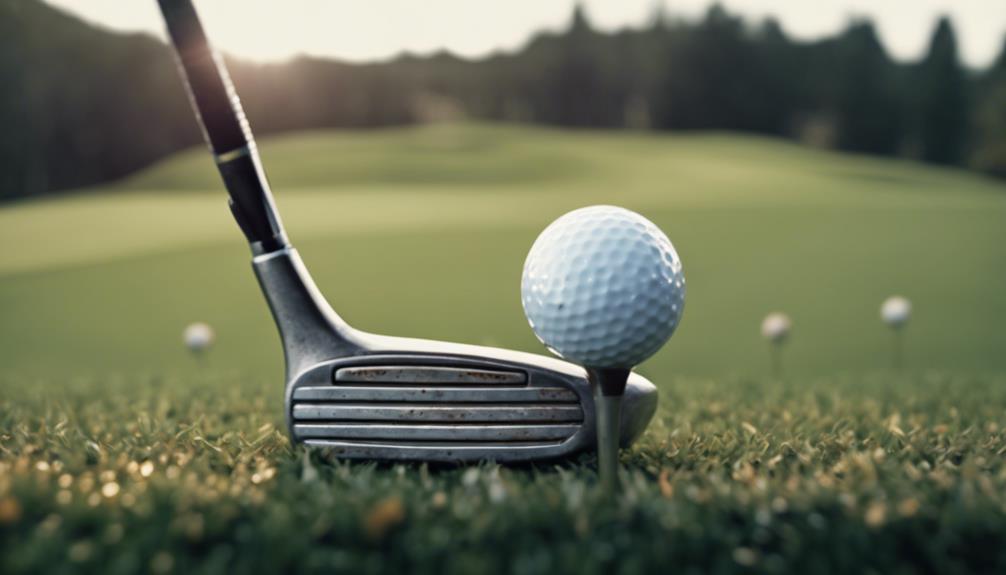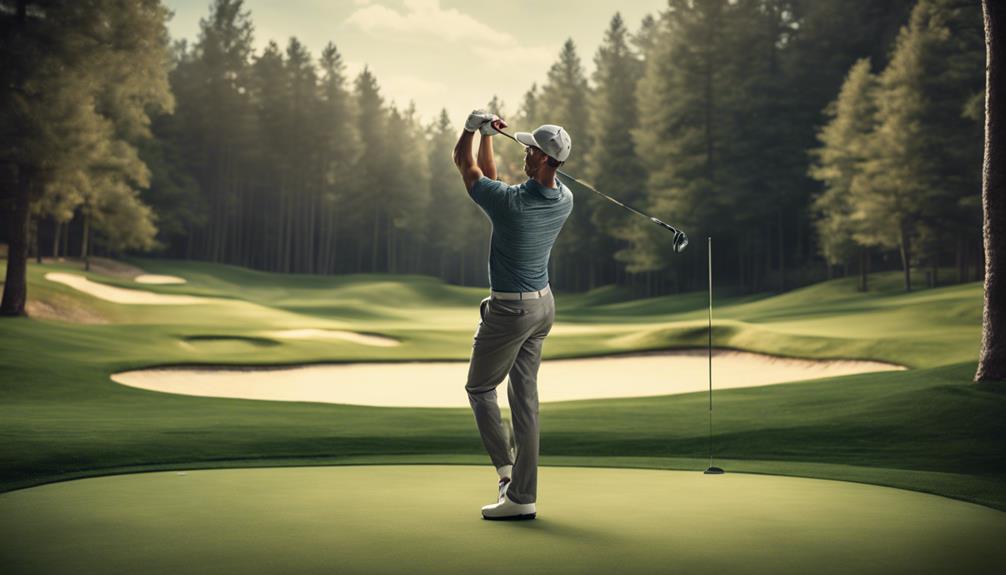- 7 Top Flite Golf Clubs XL for Improved Performance - September 28, 2024
- Top Flite Golf Clubs: Top 5 Reasons to Choose Them - September 28, 2024
- Top 3 Golf Club Fitters for a Perfect Swing - September 28, 2024
You can expect a 3% increase in performance from new golf clubs, driven by advancements in materials, design, and manufacturing technology, leading to noticeable improvements in distance, accuracy, and overall game performance. With optimized clubhead design, you'll experience increased ball speed and forgiveness on mishits. The latest materials and manufacturing techniques also enable tighter tolerances, resulting in more consistent performance across the entire set. By investing in new clubs, you'll notice improvements in your overall game, from tee to green. Now, explore how to maximize these gains and discover the full potential of your new equipment.
Key Takeaways
- New golf clubs can provide a 3% increase in performance, driven by advancements in materials, design, and manufacturing technology.
- Proper fitting and customization of new clubs can lead to significant improvements in accuracy and distance, with potential score reductions of 2-5 strokes.
- The latest materials and designs, borrowed from industries like aerospace and automotive, contribute to exceptional performance and forgiveness in new clubs.
- While new clubs can bring psychological and emotional benefits, such as renewed enthusiasm and confidence, the cost may not be justified for some golfers.
- Realistic expectations should be set, focusing on improving skills and tracking progress, rather than relying solely on new equipment for improvement.
What to Expect From Upgrades
When upgrading to new golf clubs, you can expect significant improvements in distance, accuracy, and overall performance, thanks to advancements in materials, design, and manufacturing technology.
With a new set of clubs, you'll likely notice increased ball speed, resulting in longer drives and more consistent shots. This is due to the optimized clubhead design, which allows for more efficient energy transfer at impact.
Additionally, the latest materials and manufacturing techniques enable club makers to craft clubs with tighter tolerances, leading to more consistent performance across the entire set.
To maximize these performance gains, consider consulting a professional club fitter to confirm your new clubs are tailored to your unique swing characteristics. By doing so, you'll be able to tap into the full potential of your new clubs and take your game to the next level.
With the right fit and the latest technology, you can expect to see noticeable improvements in your overall game, from tee to green.
Evolution of Golf Club Technology
As you venture into the world of new golf clubs, understanding the remarkable evolution of golf club technology is essential, which has been driven by OEMs consistently pushing the boundaries of innovation to squeeze out more performance within the rules of golf. This relentless pursuit of improvement has led to a 3% increase in performance, with significant benefits on mishits.
Here's a snapshot of the advancements in various club categories:
| Club Type | Key Innovations | Benefits |
|---|---|---|
| Drivers | Expanded maximum ball speed area | Increased forgiveness on off-center hits |
| Wedges | Higher centers of gravity, consistent spin | Preserved ball speed and distance on mishits |
| Putters | Enhanced stability, tungsten use, weight adjustability | Improved feel and roll |
| New Irons | Advanced clubhead designs, high-strength and lightweight materials | Increased stability, reduced vibration, and improved feel |
| Shafts | Graphite, steel, and hybrid options | Increased stability, reduced vibration, and improved feel |
The aerospace industry's influence is evident in the adoption of advanced materials and designs. OEMs are leveraging AI-designed faces, customizable clubheads, and cutting-edge shaft materials to create a new generation of clubs that deliver unparalleled performance.
Materials and Designs Matter

The latest golf clubs owe their exceptional performance to cutting-edge materials and designs, which have been borrowed from industries like aerospace and automotive. These advancements in materials engineering have trickled down to golf, allowing for significant improvements in distance, accuracy, and consistency.
TaylorMade's one-piece forged irons undergo an extra forging process to enhance feel. Titleist uses aerospace-grade titanium ATI425 in their TSR drivers, originally developed for industries like aerospace and defense. Callaway partnered with Lamborghini to introduce forged composites in their Diablo Octane driver.
New materials allow engineers to save weight and redistribute it for improved clubhead stability, leading to better performance and forgiveness. The use of advanced materials and designs has enabled golf clubs to achieve significant improvements in distance, accuracy, and consistency.
These cutting-edge materials and designs have revolutionized the golf industry, allowing for the creation of clubs that are more forgiving, accurate, and powerful than ever before. As a golfer, you can expect to see significant improvements in your game with the latest clubs.
Fitting and Customization Key
To tap the full potential of your new golf clubs, a precise fitting process is essential, as it determines the ideal shaft, lie, and loft tailor-made for your unique swing characteristics.
A good fitting can lead to significant improvements in accuracy and distance, with increases of 10-20 yards and reductions of 2-5 strokes in score.
During the fitting process, you'll hit your current clubs to compare with new irons, and try out different shafts and heads to find the best fit.
This thorough process involves a series of tests and measurements, including launch monitor data, swing speed analysis, and ball flight tracking, to guarantee the best possible results.
Customization options, such as adjustable weights and lie angles, can further enhance the performance of your new irons, allowing you to fine-tune your clubs to your individual swing style.
Managing Expectations and Results

When you invest in new golf clubs, you must set realistic goals and define what improvement means to you.
You should measure progress by tracking specific aspects of your game, such as driving distance or greens-in-regulation, rather than relying on vague expectations of 'getting better.'
Setting Realistic Goals
Setting realistic goals for your golf game involves identifying specific, measurable, and achievable targets that align with your current skill level and available practice time.
This is essential when getting a new set of golf clubs, as it helps you manage your expectations and focus on actual Game Improvement.
To set realistic goals, consider the following:
Assess your current set of skills and identify areas that need improvement.
Set specific targets, such as improving your drive distance or reducing your handicap.
Break down larger goals into smaller, manageable tasks to help you stay focused.
Create a practice schedule that aligns with your goals and available time.
Track your progress regularly to adjust your goals and stay motivated.
Measuring True Improvement
You've set realistic goals for your golf game, but now it's time to measure true improvement, and that means managing your expectations and results effectively.
To do this, you'll need to track your progress with precision. With your new sets, focus on speed and distance gains, as well as launch and spin rates.
A lower spin rate can lead to more consistent shots, so pay attention to this metric.
As you work on getting better, regularly review your data to identify areas for improvement. Don't get discouraged by minor setbacks – instead, use them as opportunities to refine your technique.
By monitoring your progress and making adjustments accordingly, you'll be able to accurately assess the impact of your new clubs on your game.
Remember, true improvement comes from a combination of proper technique, consistent practice, and the right equipment.
Stay focused, stay committed, and you'll be on your way to achieving your golfing goals.
Is the Investment Worth It
As you consider investing in new golf clubs, you're likely expecting significant performance gains.
However, you must separate fact from fiction and weigh the costs against the benefits to determine if the investment will truly pay off for you.
Better Performance Expected
When upgrading to new golf clubs, golfers typically expect a noticeable boost in performance, but the reality is that the latest technology often yields a modest 3% improvement. While this mightn't be a drastic change, it's still a significant advancement in technology. You mightn't notice it on every shot, but the cumulative effect can add up over the course of a round.
New materials and designs in your set of irons can lead to more consistent ball-striking and better overall performance.
Drivers and players irons can offer improved forgiveness on mishits, helping you recover from wayward shots.
The latest golf balls can provide more spin, distance, and control, giving you an edge on the course.
New technology can also provide a psychological boost, giving you more confidence and excitement to play.
Even if you don't see a huge improvement in scoring, new clubs can still provide a fresh start and renewed enthusiasm for the game.
While the performance gains mightn't be revolutionary, the latest technology can still make a tangible difference in your game.
Cost Vs. Benefit Analysis
Before investing in new golf clubs, you must weigh the cost of upgrading against the potential benefits, considering whether the latest technology will truly make a significant impact on your game. To make an informed decision, let's crunch some numbers.
| Cost | Benefit |
|---|---|
| $1,000 – $3,000 for a full set of new golf clubs | 3% improvement in performance, which may not be noticeable on the course |
| Time and effort spent getting fit for new clubs | Limited positive effects on the course, with lessons being a better way to spend money for improvement |
| Emotional high of buying new golf equipment | Psychological and ego-related benefits, rather than a major change in performance |
| Potential for a better game | Slim chances of buying a better game, unless your current clubs are old or never been fit |
As you can see, the benefits of new golf clubs are often intangible and may not justify the cost. OEMs are chasing incremental improvements, but the differences may not be noticeable on the course. So, before you decide to spend money on new golf clubs, ask yourself: will the latest technology truly make a significant impact on your game?
Frequently Asked Questions
When Should You Upgrade Golf Clubs?
"When deciding when to upgrade golf clubs, you should consider your budget constraints, personal preferences, and if you've reached performance plateaus, while also factoring in equipment evolution and your current skill levels."
What Golf Club Should I Replace First?
When deciding what club to replace first, you should prioritize irons over drivers, considering shaft material, clubhead design, grip condition, and swing weight to optimize performance, as outdated irons hinder progress and new ones offer significant improvements.
When Should You Use Different Golf Clubs?
When deciding when to use different golf clubs, you should consider course conditions, swing style, shot selection, ball position, and club head speed to optimize your game, as each factor substantially impacts club choice and overall performance.
How Can You Tell the Difference Between Golf Clubs?
When comparing golf clubs, you'll notice stark contrasts between clubhead design, shaft material, and grip size, while subtle differences in weight distribution and loft angles can profoundly impact your game, requiring a nuanced understanding to discern.
Conclusion
So, do new golf clubs make a difference?
The answer lies in the nuances of your game.
If you're willing to adapt to the latest technology and invest in a proper fitting, the results can be staggering.
But, if you're expecting a magic fix, think again.
The real question is, are you ready to put in the work to tap into the full potential of your new clubs?
The verdict is still out, but one thing's for sure – the game is about to get a whole lot more interesting.




